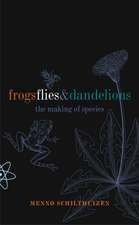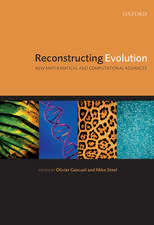Evolutionary Genetics of Invertebrate Behavior: Progress and Prospects
Autor Milton Davis Huettelen Limba Engleză Paperback – 19 aug 2013
| Toate formatele și edițiile | Preț | Express |
|---|---|---|
| Paperback (1) | 1096.98 lei 6-8 săpt. | |
| Springer Us – 19 aug 2013 | 1096.98 lei 6-8 săpt. | |
| Hardback (1) | 1104.84 lei 6-8 săpt. | |
| Springer Us – 29 iun 1987 | 1104.84 lei 6-8 săpt. |
Preț: 1096.98 lei
Preț vechi: 1154.72 lei
-5% Nou
Puncte Express: 1645
Preț estimativ în valută:
209.92€ • 220.73$ • 173.44£
209.92€ • 220.73$ • 173.44£
Carte tipărită la comandă
Livrare economică 17 aprilie-01 mai
Preluare comenzi: 021 569.72.76
Specificații
ISBN-13: 9781489934895
ISBN-10: 1489934898
Pagini: 348
Ilustrații: X, 336 p.
Dimensiuni: 155 x 235 x 18 mm
Greutate: 0.49 kg
Ediția:1986
Editura: Springer Us
Colecția Springer
Locul publicării:New York, NY, United States
ISBN-10: 1489934898
Pagini: 348
Ilustrații: X, 336 p.
Dimensiuni: 155 x 235 x 18 mm
Greutate: 0.49 kg
Ediția:1986
Editura: Springer Us
Colecția Springer
Locul publicării:New York, NY, United States
Public țintă
ResearchDescriere
In the preface to Sir Vincent B. Wigglesworth's classic 1939 book on insect physiology he asserted that insects provide an ideal medium in which to study all the problems of physiology. A strong case can be made as well for the use of insects as significant systems for the study of behavior and genetics. Contributions to genetics through decades of research on Drosophila species have made this small fly the most important metazoan in genetics research. At the same time, population and behavioral research on insects and other invertebrates have provid ed new perspectives that can be combined with the genetics approach. Through such in tegrated research we are able to identify evolutionary genetics of behavior as a highly signifi cant emerging area of interest. These perspectives are ably described by Dr. Guy Bush in the introductory chapter of this book. During March 21-24, 1983, many of the world's leading scientists in invertebrate behavioral genetics were drawn together in Gainesville, Florida, for a colloquium entitled "Evolutionary Genetics of Invertebrate Behavior." This conference was sponsored jointly by the Department of Entomology and Nematology, University of Florida, chaired by Dr. Daniel Shankland, and the Insect Attractants, Behavior and Basic Biology Research Laboratory, U.S. Department of Agriculture, directed then by Dr. Derrell Chambers.
Cuprins
Introductory Lecture.- Evolutionary Behavior Genetics.- Behavioral Variation in Natural Populations.- Behavior Genetics of Flexible Life Histories in Milkweed Bugs (Oncopeltus fasciatus).- Chromosomal Polymorphism and Vagility in Natural Populations of Drosophila pseudoobscura.- Between Population Variation in Spider Territorial Behavior: Hybrid-Pure Population Line Comparisons.- Environmental and Genetic Influences on the Social Grouping Tendency of a Communal Spider.- Genetic Constraints on the Evolution of Cannibalism in Heliothis virescens.- The Inheritance of Courtship Behavior in Schizocosa Wolf Spiders (Araneae; Lycosidae).- The Effect of Successive Founder Events on Mating Propensity of Drosophila.- Genetic and Sensory Basis of Sexual Selection in Drosophila.- Reproductive Isolation in a Neotropical Insect: Behavior and Microbiology.- Opportunities for Selection Derived from Variation in Mating Success in Milkweed Beetles (Tetraopes tetraophthalmus: Cerambycidae).- Hybridization as a Causal Mechanism of Mixed Color Broods and Unusual Color Morphs of Female Offspring in the Eastern Tiger Swallowtail Butterflies, Papilio glaucus.- Genetic Variation in the Maternal Defensive Behavior of the Lace Bug Gargaphia solani.- Behavioral Analysis of Male-Induced Interstrain Differences in Realized Fecundity in Callosobruchus maculatus.- A Genetic Analysis of Habitat Selection in the Cactophilic Species, Drosophila mojavensis.- Genetic Differences in Oviposition Preference Between Two Populations of Heliothis virescens.- Evolution of Host Plant Utilization in Colias Butterflies.- Quantitative Genetic Analysis of Feeding and Oviposition Behavior in the Polyphagous Leafminer Liriomyza sativae.- Drosophila Larval Foraging Behavior and Correlated Behaviors.- Molecular and Biochemical Genetics of Behavior.- Neurogenetics of Drosophila Circadian Rhythms.- The Behavioral Effects of a Carboxylesterase in Drosophila.- Mutants of Biological Rhythms and Conditioned Behavior in Drosophila Courtship.- Physiological Tolerance and Behavioral Avoidance of Alcohol in Drosophila: Coadaptation or Pleiotropy?.- Evolution of Egg Laying Behavior in Aplysia.- The Potential for Genetic Manipulation of the Redbanded Leafroller Moth Sex Pheromone Blend.- General and Theoretical Aspects of Behavior in Evolution and Speciation.- Generalizing Genetic Dissection of Behavior.- Extrapolating Quantitative Genetic Theory to Evolutionary Problems.- The Role of Behavior in Host-Associated Divergence in Herbivorous Insects.- The Role of Pheromones in Reproductive Isolation and Speciation of Insects.- Closing Address.- Analyzing Proximate Causes of Behavior.- Erratum.- Erratum to: Analyzing Proximate Causes of Behavior.

















